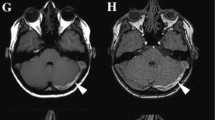Abstract
Purpose
This study sought to identify imaging criteria useful in discriminating anatomical variants from thrombosis of the posterior intracranial venous system.
Materials and methods
A total of 102 patients underwent coronal unenhanced two-dimensional time-of-flight (2D ToF) magnetic resonance (MR) venography. Transverse sinus (TS) calibre and asymmetry were considered. Oval (O-FG) and linear (L-FG) flow gaps were recorded. Several slices of the 2D ToF sequence were applied perpendicularly to the TS within each FG to avoid in-plane saturation.
Results
Mean calibre of the right TS was significantly greater than the contralateral sinus (6.5 mm±1.84 vs 5.1 mm±1.72). Right and left dominance was observed in 61% and 17% of cases, respectively. The mean right-left TS diameter was 5.77 mm. Among 204 TS, 44 L-FG and 42 O-FG were observed. Partial L-FG (<2/3 of TS) never involved the distal TS. No L-FG was observed in a dominant TS. Supplementary sagittal 2D ToF images disclosed blood flow in all but two L-FGs. O-FGs were mostly observed laterally (91%).
Conclusions
L-FGs in a dominant TS, partial L-FGs in the distal part or O-FG in the medial part of any TS, a left-right mean diameter <3 mm and absence of flow even in ToF images perpendicular to the direction of blood flow should raise the suspicion of sinus pathology.
Riassunto
Obiettivo
Scopo di questo lavoro è stato identificare i criteri neuroradiologici per discriminare le varianti anatomiche dalle trombosi dei seni venosi della fossa cranica posteriore.
Materiali e metodi
Centodue pazienti sono stati sottoposti ad angio-risonanza magnetica (RM) 2D in tempo di volo (ToF) acquisita mediante sezioni coronali senza mezzo di contrasto. Sono stati valutati calibro ed asimmetria dei seni trasversi (ST). I difetti di riempimento sono stati classificati come ovalari (DO) e lineari (DL). Per evitare la saturazione degli spin sono state effettuate alcune sezioni 2D-ToF perpendicolarmente ad ogni difetto di riempimento.
Risultati
Il diametro del ST destro è risultato significativamente più grande del controlaterale (6,5 mm±1,84 vs 5,1 mm±1,72); il diametro medio dei ST destro-sinistro è risultato di 5,77 mm. Il ST è risultato di calibro dominante a destra nel 61% ed a sinistra nel 17% dei casi. Dei 204 ST studiati, 44 presentavano DL e 42 DO. La parte distale dei ST non ha mai presentato DL parziali (meno di 2/3 del ST). Nessun DL è stato osservato nei ST dominanti. Le sezioni sagittali 2D-ToF supplementari hanno dimostrato la pervietà dei ST in tutti i DL, tranne che in due casi. I DO sono stati riscontrati nel 91% dei casi nella porzione laterale dei ST.
Conclusioni
Si dovrebbe sospettare una patologia a carico dei seni trasversi ogniqualvolta si riscontri: DL in un ST dominante; DL parziali nella parte distale del ST; DO nella parte mediale del ST; diametro medio dei ST inferiore a 3 mm; assenza di flusso ematico anche nelle sequenze 2D-ToF perpendicolari alla direzione di flusso.
Similar content being viewed by others
References/Bibliografia
Higgins JN, Gillard JH, Owler BK et al (2004) MR venography in idiopathic intracranial hypertension: unappreciated and misunderstood. J Neurol Neurosurg Psychiatry 75:621–625
Kantarci M, Dane S, Gumustekin K et al (2005) Relation between intraocular pressure and size of transverse sinuses. Neuroradiology 47:46–50
Berroir S, Grabli D, Heran F et al (2004) Cerebral sinus venous thrombosis in two patients with spontaneous intracranial hypotension. Cerebrovasc Dis 17:9–12
Majoie CB, van Straten M, Venema HW et al (2004) Multisection CT venography of the dural sinuses and cerebral veins by using matched mask bone elimination. AJNR Am J Neuroradiol 25:787–791
Nael K, Fenchel M, Salamon N et al (2006) Three-dimensional cerebral contrast-enhanced magnetic resonance venography at 3.0 Tesla: initial results using highly accelerated parallel acquisition. Invest Radiol 41:763–768
Rollins N, Ison C, Reyes T et al (2005) Cerebral MR venography in children: comparison of 2 time-of-flight and gadolinium-enhanced 3D gradient-echo techniques. Radiology 235:1011–1017
Liang L, Korogi Y, Sugahara T et al (2001) Evaluation of the intracranial dural sinuses with a 3D Contrastenhanced MP-RAGE sequence: prospective comparison with 2D-TOF MR venography and digital subtraction angiography. AJNR Am J Neuroradiol 22:481–492
Liauw L, Van Buchem MA, Spilt A et al (2000) MR angiography of the intracranial venous system. Radiology 214:678–682
Baikov DE, Mufazalov FF, Gerasimova LP (2007) Magneto-resonance tomography in evaluation variations of development of large-scale conjugated sinus of the posterior cranium fossa and interior jugular veins. Medical Journal of Bashkortostan 2:73–75
Alper F, Kantarci M, Dane S (2004) Importance of anatomical asymmetries of transverse sinuses: An MR venographic study. Cerebrovasc Dis 18:236–239
Ayanzen RH, Bird CR, Keller PJ (2001) Cerebral MR venography: normal anatomy and potential diagnostic pitfalls. AJNR Am J Neuroradiol 22:481–492
Widjaja E, Griffiths PD (2004) Intracranial MR venography in children: normal anatomy and variations. AJNR Am J Neuroradiol 25:1557–1562
Durgun B, Ilgit ET, Cizmeli MQ (1993) Evaluation by angiography of the lateral dominance of the drainage of the dural venous sinuses. Surg Radiol Anat 15:125–130
Surendrababu NRS, Subathira, Livingstone RS (2006) Variation in the cerebral venous anatomy and pitfalls in the diagnosis of cerebral venous sinus thrombosis: low field MR experience. Indian Journal of Medical Sciences 4:135–142
Rhoton AL (2000) Jugular foramen. Neurosurgery 47:267–285
Gailloud P, Muster M, Khaw N et al (2001) Anatomic relationship between arachnoid granulations in the transverse sinus and the termination of the vein of Labbé: an angiographic study. Neuroradiology 43:139–143
Koshikawa T, Naganawa S, Fukatsu H (2000) Arachnoid granulations on highresolution MR images and diffusion-weighted MR images: normal appearance and frequency. Radiat Med 18:187–191
Author information
Authors and Affiliations
Corresponding author
Rights and permissions
About this article
Cite this article
Manara, R., Mardari, R., Ermani, M. et al. Transverse dural sinuses: incidence of anatomical variants and flow artefacts with 2D time-of-flight MR venography at 1 Tesla. Radiol med 115, 326–338 (2010). https://doi.org/10.1007/s11547-010-0480-9
Received:
Accepted:
Published:
Issue Date:
DOI: https://doi.org/10.1007/s11547-010-0480-9
Keywords
- Time-of-flight MR venography
- Flow artefacts
- Transverse sinuses
- Anatomical variants
- Venous sinus thrombosis




